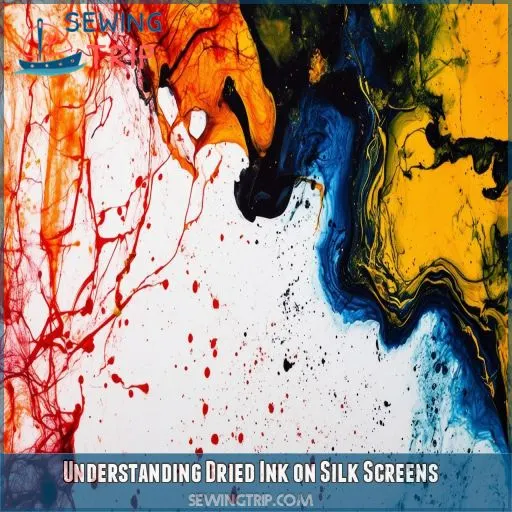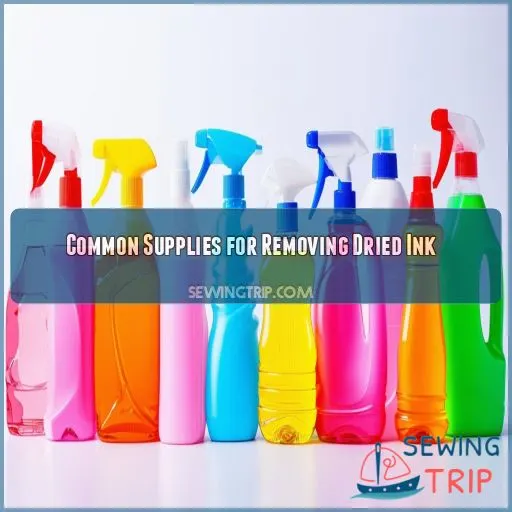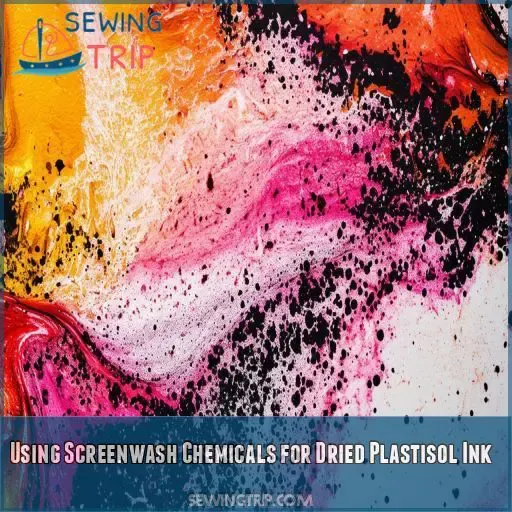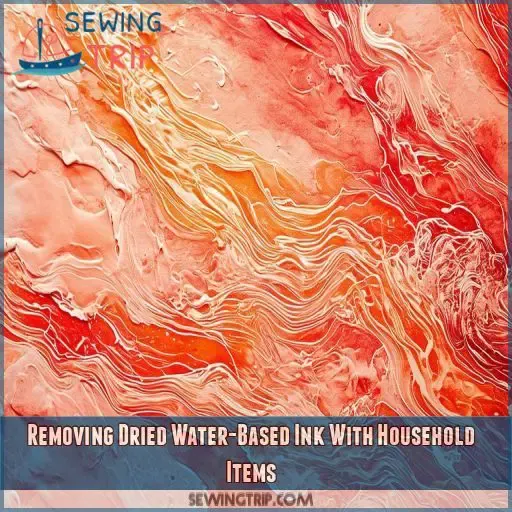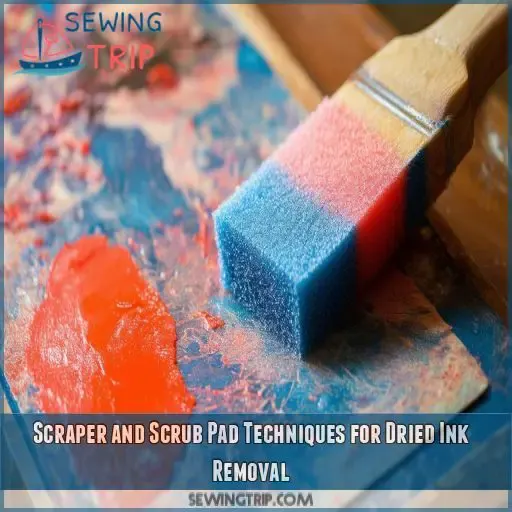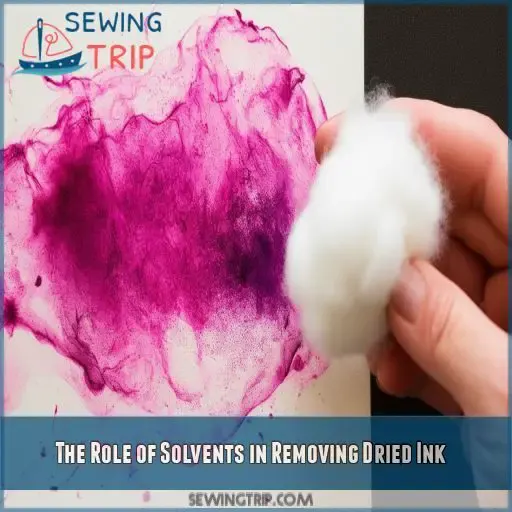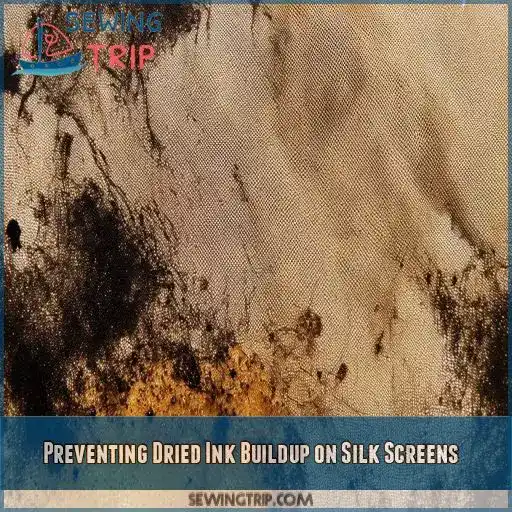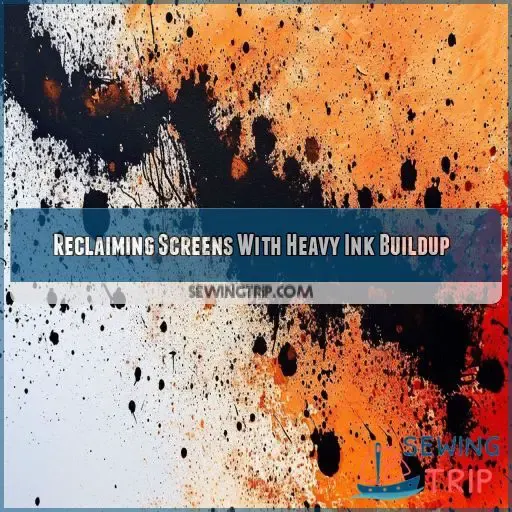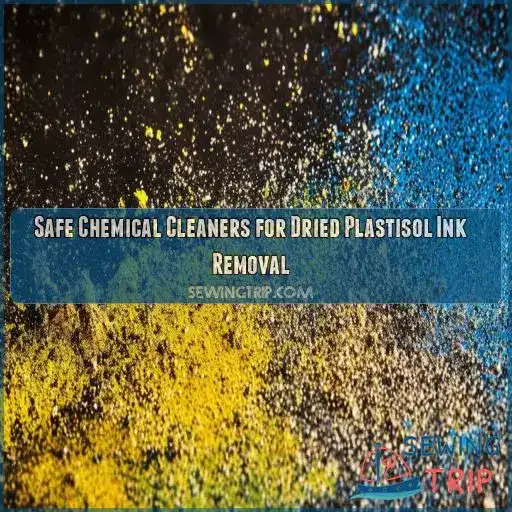This site is supported by our readers. We may earn a commission, at no cost to you, if you purchase through links.
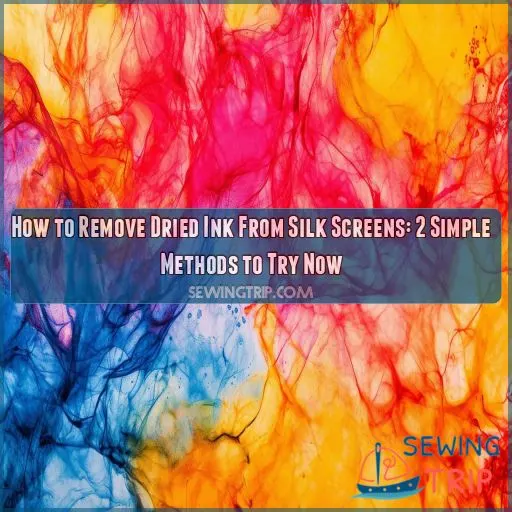
We’ll cover removing oil-based and plastisol ink, as well as dried water-based ink with household items. Plus, learn how to prevent dried ink buildup and reclaim screens with heavy ink residue.
Get ready to rescue your silk screens and keep them in top condition!
Table Of Contents
- Key Takeaways
- How to Remove Dried Ink From Silk Screen?
- Understanding Dried Ink on Silk Screens
- Common Supplies for Removing Dried Ink
- Using Screenwash Chemicals for Dried Plastisol Ink
- Removing Dried Water-Based Ink With Household Items
- Scraper and Scrub Pad Techniques for Dried Ink Removal
- The Role of Solvents in Removing Dried Ink
- Preventing Dried Ink Buildup on Silk Screens
- Reclaiming Screens With Heavy Ink Buildup
- Safe Chemical Cleaners for Dried Plastisol Ink Removal
- Frequently Asked Questions (FAQs)
- Conclusion
Key Takeaways
- Tackling dried ink on silk screens is like wrestling a stubborn opponent: opt for precision over force.
- Vinegar and baking soda are your secret weapons against water-based ink; they’ll break it down efficiently.
- For dried plastisol ink, screenwash chemicals are ideal – they’ll make the ink disappear.
- Preventative measures are key: maintain your screens with care to sidestep the hassle of dried ink.
How to Remove Dried Ink From Silk Screen?
Removing dried ink from silk screens is a straightforward process if you use the right tools and methods. There are a variety of supplies and techniques to help with this process, depending on the type of ink you’re dealing with. For instance, dried plastisol ink can be removed with screenwash chemicals, while dried water-based ink responds to household items like vinegar and baking soda.
There’s more to uncover about these methods, so keep going to find out more.
Understanding Dried Ink on Silk Screens
Dried ink on your silk screen can lead to a variety of issues, including mesh clogging and stencil blockage, which ultimately result in poor print quality.
Those flakes and chunks of dried ink can find their way onto your prints, compromising the final product.
The thick buildup can clog mesh openings, causing poor ink coverage and even sticking or scarring as the squeegee drags across.
Common Supplies for Removing Dried Ink
Removing dried ink from silk screens requires the right supplies. Here are some common tools and techniques to help you tackle this task effectively:
- Screenwash Chemicals: These are designed to break down and remove dried ink from screens. Consider "screen wash" or "ink remover."
- Solvents: Try common household solvents like nail polish remover (with acetone) to dissolve ink. Test first to prevent screen damage.
- Scrapers: Gently lift dried ink with plastic scrapers like old credit cards. Avoid scratching the mesh.
- Scrubbers: Soft-bristled brushes or nylon pads scrub away ink residue. No abrasives or heavy pressure, please!
Using Screenwash Chemicals for Dried Plastisol Ink
When tackling dried plastisol ink on your silk screens, one effective approach is to use screenwash chemicals. This method involves carefully selecting a suitable chemical solution, applying it to the screen, and then employing gentle scrubbing techniques to loosen and remove the stubborn ink.
The process begins with choosing the right chemical for the job. Screenwash chemicals are specifically designed to break down and dissolve dried plastisol ink, so selecting one that’s compatible with this type of ink is key. You’ll want to opt for a product that’s both effective and safe for use on silk screens, ensuring it won’t damage the mesh or leave behind any harmful residues.
Once you’ve selected the appropriate chemical, it’s time to apply it to the screen. Follow the manufacturer’s instructions for proper usage, paying close attention to safety precautions and recommended application methods. Allow the chemical to sit on the screen for the suggested duration, giving it ample time to penetrate and loosen the dried ink.
The next step involves gentle scrubbing. Using a soft nylon pad or a non-abrasive scrubber, work the chemical into the mesh, carefully scrubbing in a circular motion. This action helps to dislodge the ink buildup without causing damage to the delicate screen material. Rinse the screen thoroughly with water at the recommended temperature, ensuring that all traces of the chemical and loosened ink are washed away.
Removing Dried Water-Based Ink With Household Items
If you’re dealing with water-based ink on your silk screens, there are a few gentle yet effective removal methods using common household products.
Vinegar, a natural solvent, can help break down old ink stains. Apply vinegar to a clean rag and gently rub the affected areas.
Baking soda is another powerful stain remover. Create a paste with baking soda and water, then use a clean rag to gently scrub the paste onto the dried ink.
Hand sanitizer, which is typically readily available, can also dissolve water-based ink. Apply a small amount to a clean rag and gently rub the ink until it starts to break down.
Remember to be gentle when using these methods to avoid damaging the delicate mesh of your silk screen.
Scraper and Scrub Pad Techniques for Dried Ink Removal
Now, let’s delve into some practical techniques for removing dried ink using scrapers and scrub pads.
When tackling dried ink on your silk screens, it’s crucial to avoid using abrasive tools or applying excessive pressure. Opt for gentle scrubbing techniques, and always exercise caution to prevent damaging your screens.
Scrapers, such as credit cards or plastic cards, can be effective tools for removing dried ink. Gently work the scraper across the screen to lift and remove the dried ink. This method is particularly useful for breaking up and removing thicker ink deposits.
For a more thorough clean, pair your scraper with a scrub pad. Nylon scrub pads, in particular, are excellent for gently scrubbing away dried ink without causing damage to your screens. Remember to always scrub in a gentle, circular motion, and avoid using excessive pressure.
The Role of Solvents in Removing Dried Ink
Solvents are a powerful tool for breaking down dried ink, but they require careful handling to ensure effectiveness and safety. Here’s what you need to know about using solvents to remove dried ink from silk screens:
- Solvent Effectiveness: Choose the right solvent for the job. Some solvents are more effective on certain types of ink. For example, nail polish remover (which contains acetone) works well on water-based inks.
- Solvent Safety: Always wear gloves when handling solvents, and work in a well-ventilated area to avoid inhaling toxic fumes.
- Solvent Toxicity: Many solvents are highly toxic and flammable, so proper ventilation and protective gear are essential.
- solvent disposal and Alternatives: Dispose of used solvents properly and responsibly. Avoid pouring them down the drain as they can contaminate water sources. Consider less toxic alternatives, such as natural solvents derived from citrus or soy.
Preventing Dried Ink Buildup on Silk Screens
Keeping your silk screens free of dried ink is essential for maintaining their performance and longevity. Here are some tips to prevent dried ink buildup:
| Tip | Description | Benefits |
|---|---|---|
| Clean Screens Immediately | Always clean your screens right after printing. | Prevents ink from drying and building up. |
| Off-Contact Adjustment | Make sure proper off-contact distance to avoid ink transfer when the screen is in the up position. | Reduces ink residue on the screen. |
| Flash Cure Unit | Adjust the flash cure unit to prevent ink from drying on the screen. | Optimizes curing and reduces ink buildup. |
| Mesh Replacement | Periodically replace the screen mesh to maintain ideal tension and prevent ink accumulation. | Enhances print quality and reduces mesh-related issues. |
| Best Practices | Follow recommended practices for ink application, curing, and storage to minimize residue. | Reduces the risk of ink drying and buildup. |
| Repeat and Store | Repeat the cleaning process after each use and store screens properly to prevent ink drying. | Maintains screen performance and longevity. |
Reclaiming Screens With Heavy Ink Buildup
If your silk screens have substantial ink accumulation, you may need to contemplate remeshing them. This process involves removing the old mesh and replacing it with new mesh fabric. It’s a time-consuming process, but it guarantees your screens are as good as new.
Appropriate stencil upkeep is also essential. Regularly cleanse your stencils with a pH-balanced solution to avert ink buildup. Maintaining the correct pH balance will also support protecting your screens from corrosion.
Another option for reclaiming screens is to remove the emulsion. This process involves submerging the screen in an emulsion remover, which breaks down the emulsion and enables you to rinse away the ink buildup.
Additionally, maintaining adequate screen tension is critical. Screens with good tension will last longer and are less likely to develop substantial ink buildup. Consider investing in a press wipe system to keep your screens clean and preserve their tension.
For extremely heavy ink buildup, a pressure washer can be a useful tool. It effectively removes ink and restores your screens to their original state. Just ensure to wear protective gear when utilizing a pressure washer to stay safe.
Safe Chemical Cleaners for Dried Plastisol Ink Removal
When it comes to dried plastisol ink removal, you should guarantee that you’re using safe chemical cleaners that are efficient and environmentally conscious. It’s important to reckon the environmental impact and potential chemical hazards associated with certain solvents and cleaning agents. While some heavy-duty chemicals may get the job done, they might also have adverse effects on both your health and the environment.
Look for alternative methods or products that are specifically designed for silk screen printing and ink removal. These products should have a good balance of effectiveness and safety, ensuring that they can break down and remove the dried plastisol ink without causing any harm. Additionally, take into account the biodegradability of the chemicals you use. Opt for products that are biodegradable, as they’ll have less of an impact on the environment during disposal. Always follow the disposal guidelines provided by the manufacturer to ensure proper handling and disposal of any chemical waste.
Frequently Asked Questions (FAQs)
How to get ink out of silk screen?
Removing dried ink from silk screens is challenging, especially with oil- or plastisol-based inks. To tackle this, use mild dishwashing detergent, soft brushes, and water. Avoid heavy pressure in areas with caked or dried ink to prevent brush piercing.
How to get dried ink out of a screen?
You can use screen wash, ink remover, or nail polish remover. For plastisol ink, scrub gently with a nylon pad after applying screen wash or ink remover. Rinse thoroughly. For water-based ink, apply nail polish remover, wipe off residue, and wash with dish soap.
What dissolves screen printing ink?
You can use chemical solvents like acetone, rubbing alcohol, or paint thinner to dissolve screen printing ink. For a more natural approach, try scrubbing gently with a soft-bristled brush and rinsing with water.
How do you remove dried emulsion from silk screen?
To remove dried emulsion, wet the screen, spray on emulsion remover, and scrub with a brush until the emulsion breaks down. Rinse with a pressure washer.
What are the risks of harsh detergents on silkscreens?
Using harsh detergents on silkscreens can damage the fragile silk fibers, causing fraying, shredding, felting, or puckering. It can also lead to discoloration and stiffening of the fabric over time.
Whats the best way to store a silk screen post-cleaning?
After cleaning your silk screen, make sure to dry it completely before reuse. Store it in a plastic bag or protective sleeve, in a cool, dry place away from sunlight.
How long should I leave ink remover on dried ink?
You should leave ink remover on dried ink for 5-15 minutes. Set a timer to make sure you don’t lose track of time.
What pressure washer settings ensure effective cleaning?
When pressure washing silk screens, use a pressure setting of 500 to 1500 PSI. Use a low-pressure setting and a wide-angle spray tip to avoid damaging the screens.
Which gloves are best for handling ink remover?
When handling ink remover, it’s important to protect your skin. Disposable latex or nitrile gloves are a good option, as they create a barrier between your skin and the ink. Gloves with a gauntlet design can also protect your wrist and forearm if you need to submerge your hands in ink.
Conclusion
Removing dried ink from silk screens doesn’t have to be difficult. With the correct techniques and supplies, you can easily tackle oil-based, plastisol, and water-based ink residue.
Whether you choose to use screenwash chemicals, household items, or heavy-duty reclamation methods, the following steps will guide you through the process of restoring your silk screens to their original condition.

